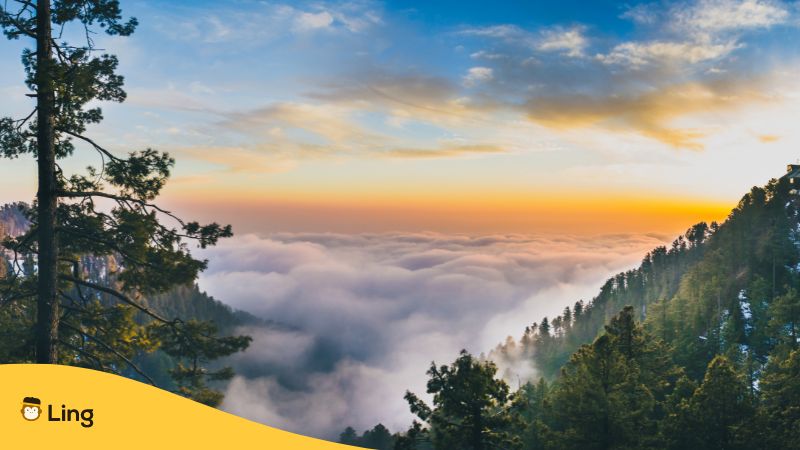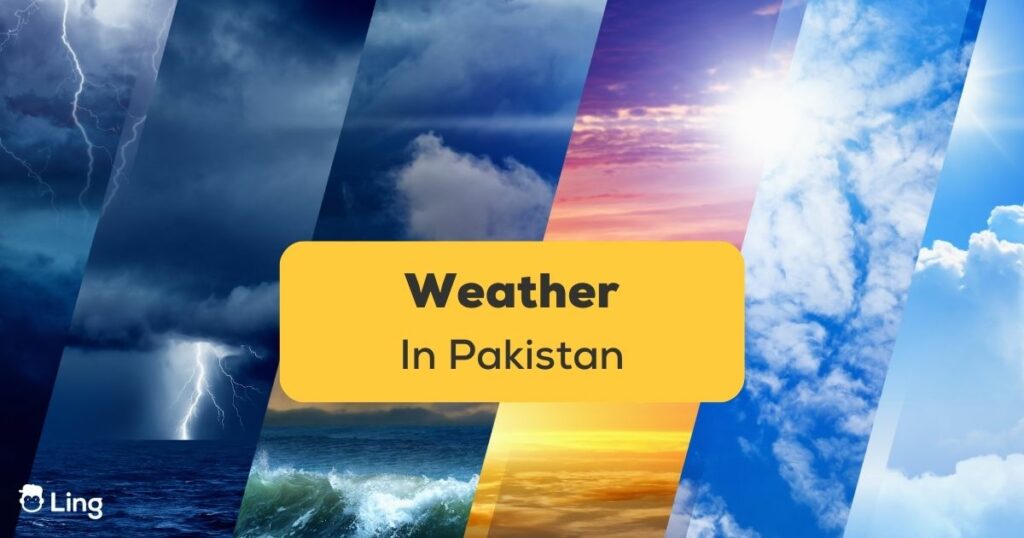Pakistan has a diverse climate, ranging from hot and arid in the south to temperate and cold in the north. The country experiences four distinct seasons: summer, winter, monsoon, and post-monsoon. Each season brings its own unique weather, i.e., موسم (mausam) conditions. In this blog post, we will describe the weather in Pakistan and discuss the major climate patterns that influence it. We will also explore some of the unique features of the climate in different parts of the country and the best times to visit each region while learning new vocabulary in Urdu.
The Climate Of Pakistan
Pakistan has a continental climate, with hot summers and cold winters. The highest mountain range in the world, the Karakoram, can also experience temperatures of -20°C (-4°F) during the winter months. Basically, there are four major seasons in the country:
- a cool, dry winter = December to February
- a hot, dry spring = March through May
- the summer rainy season = June to September
- the retreating monsoons = October to November
The Weather Patterns In Pakistan
Pakistan’s weather patterns are highly variable and unpredictable due to its location in a region that experiences a wide range of climatic variations. The weather is usually hottest during the summer, while winter brings colder temperatures, especially in northern Pakistan.
Rainfall patterns vary significantly across the country. The mountainous regions generally experience more rainfall than the plains and deserts. Flash floods are common during the monsoon season in some parts of the country. In some areas, particularly in the north, snowfall is expected during winter.
Pakistan also experiences high winds during the winter, when the jet stream flows southwards, bringing strong winds from the Mediterranean Sea. In addition, tropical storms, known as ‘Cyclones,’ bring heavy rain and wind during the summer months, mainly in Sindh, Punjab, and Balochistan.
Pakistan has hot summers with temperatures reaching up to 45 degrees Celsius. These extreme temperatures are experienced mainly in central and southern Pakistan and can be dangerous due to the increased risk of heat stroke and dehydration.
The Best Time To Visit Pakistan

The best time to visit Pakistan varies depending on what part of the country you plan to visit. Generally speaking, the best time to visit is from October to April when the weather is cooler, and there is less chance of rainfall. For those wanting to see snowfall, December and January are the best times to visit.
Overall, the weather in Pakistan can be unpredictable and should be considered when planning a trip. However, its rich culture, vibrant cities, and stunning landscapes make it an attractive destination for travelers.
Urdu Weather Vocabulary
Want to enjoy your travel? Learning the Urdu language can certainly help. In this section, let’s focus on mastering the common Urdu words you can use when describing weather conditions.
- بارش (Barish): This is used to describe when it is raining.
- گرمی (Garmi): This term is used to describe hot temperatures.
- برسات (Barsaat): This term is used to describe a storm, whether it is thunder, lightning, or hail.
- ہوا (Hawa): This term is used to describe a light breeze or strong wind.
- خاموش (Khaamosh): This term is used to describe a peaceful atmosphere with no wind or rain.
- دھول (Dhool): This term is used to describe dust in the air.
- سردی (Sardi): This term is used to describe cold temperatures.
- اداسی (Udaasi): This term is used to describe the feeling of sadness that can come with bad weather.
- طوفان (Tuufaan): This term is used to describe a severe tropical cyclone.
By learning some key Urdu weather words and phrases, you can better understand Pakistan’s climate and how it impacts people’s lives.
Other Weather-Related Urdu Vocabulary
Let’s look at a list of helpful vocabulary to further expand your learning.
A-N
| English | Urdu | Romanization |
| Air | ہوا | Hwa |
| Air Pressure | ہوا کا دباؤ | Hwa Ka Dabao |
| Barometric | بیرومیٹرک | Barometric |
| Blizzard | برفانی طوفان | Barfani Tufaan |
| Balmy | بالمی | Balmy |
| City | شہر | Sheher |
| Climate | آب و ہوا | Aabb O Hwa |
| Cloud | بادل | Baadal |
| Cloudy | ابر آلود | Abr Alood |
| Day | دن | Din |
| Dew | اوس | Oas |
| Downpour | موسلا دھار بارش | Mosla Dhaar Barish |
| Drizzle | بوندا باندی | Bonda Bandi |
| Flash Flood | سیلابی ریلے | Selabi Railay |
| Flood | سیلاب | Selaab |
| Fog | دھند | Dhund |
| Gale | آندھی | Aandhi |
| Gust | جھونکا | Jhaunka |
| Hail | اولے | Olay |
| Heat | گرمی | Garmi |
| Heat Index | ہیٹ انڈیکس | Hate Index |
| Heat Wave | گرمی کی لہر | Garmi Ki Lehar |
| Ice Storm | برف کا طوفان | Barf Ka Tufaan |
| Icicle | برفانی | Barfani |
| Isobar | اسوبار | Esobaar |
| Lightning | بجلی | Bijli |
| Low Pressure | کم دباو | Kam Dabao |
| Mist | دوبد | Dobad |
| Moisture | نمی | Nami |
O-Z
| English | Urdu | Romanization |
| Outlook | آؤٹ لک | Out Look |
| Overcast | ابر آلود | Abr Alood |
| Permafrost | پرما فراسٹ۔ | Permafrost |
| Precipitation | ورن | Waran |
| Pressure | دباؤ | Dabao |
| Rain | بارش | Barish |
| Rain Gage | رین گیج | Rain Gij |
| Sun | سورج | Sooraj |
| Site | سائٹ | Site |
| Shower | شاور | Shower |
| Sky | آسمان | Aasman |
| Smog | سموگ | Smog |
| Temperature | درجہ حرارت | Darja Hararat |
| Thunder | گرج | Garaj |
| Thunderstorm | گرج چمک | Garaj Chamak |
| Tornado | طوفان | Tufaan |
| Tropical | اشنکٹبندیی | Ashanktabadi |
| Warm | گرم | Garam |
| Water Cycle | آبی چکر | Aabi Chakkar |
| Weather | موسم | Mausam |
| Whirlwind | آندھی | Aandhi |
| Wind | ہوا | Hwa |
| Wind Chill | یخ بستہ ہوا | Yakh Basta Hwa |
| Winter | موسم سرما | Mausam Sarma |
Wrapping Up

That’s all about the Pakistani weather. If you want to learn more about this beautiful language, then head towards Ling, as it can help you with 60+ languages, including Urdu and other Asian languages. You can spend 10 minutes every day and ace any language learning goals faster, thanks to its unique features and in-depth lesson guides. Download the app from Google Play Store or App Store and start learning the Urdu language.



































































